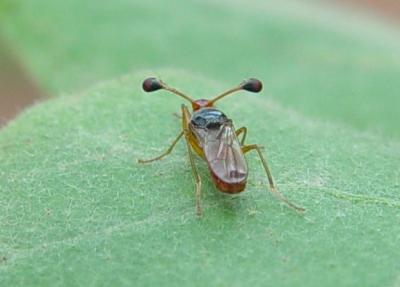

Stalk-eyed shoot flies (Diopsis spp.)
The dark brown flies are about 8 mm in length, and have the eyes situated on 2 long stalks projecting from both sides of the head. Flies lay eggs singly on the upper surface of young leaves, or on the leaf sheath of older plants. The whitish maggots that hatch from the eggs penetrate into the growing zone (heart) of the plant. As a result of maggot feeding the central whorl does not open, but dries-up and dies, producing what is commonly known as "dead heart".
Maggots move readily from one tiller to another. One maggot can destroy up to 10 neighbouring tillers. Later generations feed on the developing flower head. Pupation normally occurs in the first 3 leaf sheath of healthy tillers, generally one pupa per tiller. A severe attack is likely to occur when water levels are low. Such attacks reduce yields of rice plants. Shoot fly attack rice plants early in the crop growth stage, shortly after emergence in direct-seeded fields or shortly after transplanting. They are present throughout the crop growth period, although infestation is low in the flowering-ripening stages.
- Practise early and synchronised planting.
- Proper plant spacing. There are indications that damage increase with an increases in plant density (Heinrich and Barrion, 2004).
- Apply calcium silicate to strengthen stem tissues.
- Avoid panicle harvesting (leaving tall stems) and destroy stubbles after harvest.
- Water management: keep basis of stems always under water.
- Conserve natural enemies. Spiders are the main natural enemies of these flies.
- The cultivars "WAB 1159-2-12-11-6-9-1-2" has been reported in Uganda to trap Diopsis thoracica larvae with their highly hairy leaves (WARDA).
